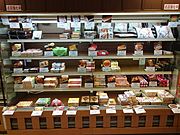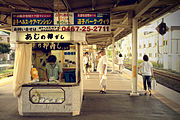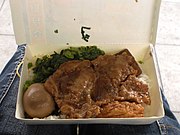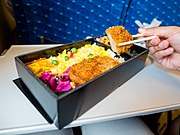Ekiben
 A typical 1000 Yen ekiben from Tokyo Station | |
| Type | Boxed meal |
|---|---|
| Associated cuisine | Japan |
Ekiben (駅弁, railway boxed meals) are a specific type of bento boxed meals, sold on trains and train stations in Japan. They come with disposable chopsticks (when necessary) or spoons. Ekiben containers can be made from plastic, wood, or ceramic. Many train stations have become famous for their ekiben made from local food specialties (tokusanhin).
Ekiben were first sold in railway stations in the late 19th century, and developed at a time when meals on train were necessary during a long train journey. Sales of ekiben reached a peak in the 1980s, but declined as air travel became more popular and trains became faster. However, numerous types of ekiben can still be purchased at stands in the station, on the platform, or on the train itself, some of which may be presented in unique containers that can serve as souvenirs for the travelers.
Ekiben style meals are also popular around East Asia especially Taiwan (see Taiwan Railway Mealbox).
History

The word ekiben comes from "eki", meaning railway station, and "ben", which is short for bento (box meal).[1] Before the introduction of rail travel, travellers would prepare their own meal or buy meals kept in wooden bento boxes sold in tea houses. During the intermission of kabuki theatre performances, makunouchi-bento ("between-acts box lunches") were also sold. These would evolve into ekiben with the coming of railways. The first sale of ekiben is generally believed to have been at the Utsunomiya Station in 1885 which opened when the Nihon Tetsudo line linked the station to Ueno Station in Tokyo.[2] In the beginning the ekiben offered were simple fare, the ekiben offered at Utsunomiya Station were simply onigiri (rice balls) wrapped in young bamboo leaves.[2] The idea of selling ekiben quickly spread to railway stations around the country, and in 1888, the first standard ekiben with rice and a few side dishes were sold at Himeji Station.[3] At the beginning of the 20th century, many stations began to offer ekiben that served meals prepared from local specialties, and ekiben then evolved into a form of meal distinct from other bento boxes. These may be developed specially and are unique to each region, and often found only at the local railway stations.[4] A well-known example is ikameshi, squid stuffed with rice, served at the Mori Station in Hokkaido. It was first produced as an ekiben meal but has since become a noted regional dish.[1]
Rail travel in Japan boomed after the Second World War, and the popularity of ekiben was spurred in the 1970s by a drama based on a manga about a person who travelled round Japan to taste the ebiken. At its height in the mid 1980s, it was estimated that twelve million boxes were consumed daily.[3] This "Golden Age" of ekiben, however, ended in the 1980s when air travel became popular and faster trains were introduced. Prior to the 1980s, air travel was expensive and travelers tended to use trains which were then much slower, therefore ekiben were necessary during their long train journeys.[5] Faster trains such as Shinkansen also eliminated many stops along a railway journey, which contributed to its decline, and some stations no longer offer ekiben.[1] From 1987 to 2008, there was a 50% decline in the number of ekiben makers. In many places, ekiben have become souvenirs of local specialty for tourists with unique containers and attractive packaging.[3][6]
Ekiben are now also available outside of railway station in department stores and airports. Annual ekiben fairs are held at various department stores, the first of which was held in 1966. The largest of these are the ones at the Keio Department Store in Shinjuku Station, Tokyo, and at Hanshin Department Store in Osaka.[1]
Types
There many types of different ekiben available. These may be grouped into two major categories of ekiben: makunouchi-bento which is the standard ekiben available all over Japan, and typically features rice, grilled fish, fish cakes, pickles, and other standard elements; and regional ekiben that offers a wide variety of regional dishes unique to each specific region.
Gallery
-
A variety of ekiben on sale in railway station
-
Ekiben shop on a platform (Kamakura Station)
-
A regular Taiwan Railway Mealbox for 60NTD (2USD)
-
Ekiben meal box in the shape of a Shinkansen bullet train
-
Example Bento sold from the Hiroshima Station
See also
- Ikameshi: a regional dish composed of squid cooked with rice inside
- Kamameshi: dish of rice, meat, and vegetables cooked in a pot
- Kyaraben: elaborately arranged bento
- Masuzushi: a form of ekiben, with oshizushi
- Taiwan Railway Mealbox
References
- ^ a b c d "Ekiben: Taste the Romance of Travel". Tokyo Restaurants Guide.
- ^ a b Yoko Hani (January 5, 2003). "Japan's own meals on wheels". The Japan Times.
- ^ a b c Lombardi, Linda (July 15, 2015). "Ekiben! Japanese Food on Japanese Trains and Beyond". Tofugu.
- ^ Shun Gate (April 29, 2017). "Ekiben Reflects the taste, culture and passion of each region". Tokyo Business Today.
- ^ "Junshin Hayashi; Shinobu Kobayashi, Ekibengaku koza" (in Japanese). Shueisha, Japan. 2000-09-01. ISBN 9784087200522. Retrieved 2008-06-26.
- ^ Amy Chavez (November 3, 2015). "The cutest, must-have bento lunchboxes you can buy and eat on the train". Sora News 24.





